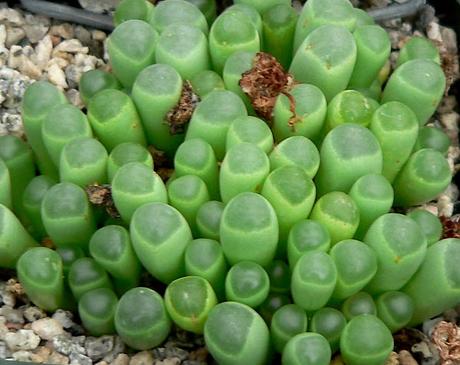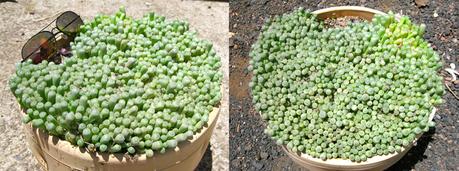 Fenestraria rhopalophylla ssp. aurantiaca belongs to the family of Aizoaceae. There are various common names, such as babies’ toes or window plant. It´s native to Namibia and Namaqualand in South Africa into the Richtersveld. F. rhopalophylla seems like Frithia pulchra, but its leaves are different because it has yellow flowers, compared with the pink flowers of F. pulchra. The most curious thing is that this succulent plant has unusual leaves with a translucent window on the top, for that is called little “fingers” seems to have eyes on them. Each “finger” has a transparent window at its tip to filter sunlight. On each sheet there is a transparent area, like a window so its Latin name refers to it: “fenestra” (window). This allows photosynthesis That leaves are about 2-2.5 cm in length and its apex is thickened.
Fenestraria rhopalophylla ssp. aurantiaca belongs to the family of Aizoaceae. There are various common names, such as babies’ toes or window plant. It´s native to Namibia and Namaqualand in South Africa into the Richtersveld. F. rhopalophylla seems like Frithia pulchra, but its leaves are different because it has yellow flowers, compared with the pink flowers of F. pulchra. The most curious thing is that this succulent plant has unusual leaves with a translucent window on the top, for that is called little “fingers” seems to have eyes on them. Each “finger” has a transparent window at its tip to filter sunlight. On each sheet there is a transparent area, like a window so its Latin name refers to it: “fenestra” (window). This allows photosynthesis That leaves are about 2-2.5 cm in length and its apex is thickened.
As the story of the swan, this plant becomes a beautiful and a colorful yellow plant
Click To Tweet
In the wild, the plant commonly grows under sand, except for the transparent tips, which allow light into the leaves for photosynthesis .Therefore, this plant is often covered by sand and transparent sheets allow us to light for photosynthesis comes. The plant grows in sandy soils with less than 100 mm of annual rainfall.

Fenestraria rhopalophylla on Canarius.com
It’s bloom in summer, autumn and even winter. It´s very sensitive to frost. The level of the compound in the pot should be slightly below the root collar to be placed above a layer of fine gravel that covers the neck and half the height of the leaves. The lack of light due tissues and rots easily. It should be watered in the growing season, from summer to autumn, but require little water. They should be kept dry during the winter.

